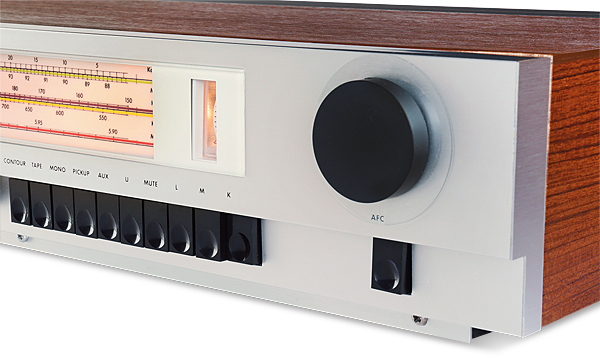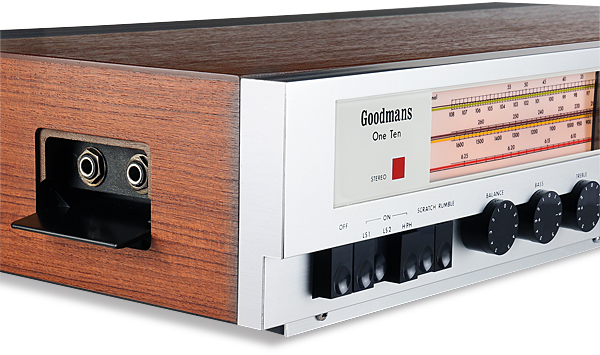Goodmans One Ten Receiver

 Handsome, affordable and boasting a top-notch tuner to boot, should this early '70s receiver top your list when it comes to securing a pre-cherished radio star? We find out
Handsome, affordable and boasting a top-notch tuner to boot, should this early '70s receiver top your list when it comes to securing a pre-cherished radio star? We find out
Almost all audio enthusiasts will know Goodmans for its range of loudspeakers. However, the company's other hi-fi products are less well remembered, despite the fact that more than one or two achieved considerable popularity among buyers.
One example is the One Ten receiver we have here. Designed along European lines, it was launched in 1972 and came in two finishes: a natural aluminium fascia with black controls and a sleeve in teak, rosewood or walnut; or a black fascia with a white sleeve and a mix of white and multi-coloured controls. The latter version saw the colours of the waveband switches match the stripes on the tuning dial.
Thorn To Run
The One Ten drew on work Goodmans had undertaken in the decade or so before. With the Maxamp from 1963 it had become one of the first British manufacturers to bring a transistorised stereo amplifier to market, and this was later augmented by the Stereomax FM tuner. This compact pairing defined a style and format that would later be reprised by Sony with its TA-88/ST-88 [HFN Apr '12].

Being a combined stereo tuner and amplifier, the receiver was a key hi-fi product in the late 1960s and early '70s. The big European names were making the running as the Japanese companies marketing receivers were styling them for an American audience, which wasn't always to the taste of British consumers. On the other hand, models such as the B&O Beomaster 3000 and Braun Regie 510 [HFN Jun '16] were aspirational products that motivated many other firms to produce something similar.
Around this time Goodmans found itself under the wing of the vast Thorn organisation whose other brands included Ferguson, HMV, Ultra and Marconi. Thorn had tried to enter the market for top-end hi-fi previously, having taken control of Beam Echo/Avantic [HFN Dec '18] in the early 1960s. This venture sadly came at a time of crisis for the TV industry as the British government prematurely announced the ending of the 405-line system. This left Thorn and its competitors with warehouses full of TV sets the public no longer wanted to buy. Amid the chaos the Avantic project was quietly dumped, but a decade later the firm was ready for another try.
Goodmans was given the full support of Thorn's electronics know-how and mass production expertise. The first fruits of this collaboration was an intriguing line of receivers that began in 1971 with the Module 80. This was a capable design having a power rating of 35W per channel into 4ohm, an FM tuner with full-band coverage, and a built-in stereo decoder.

Cabinet Shuffle
The One Ten arrived the following year boasting improved performance and a striking new cabinet design. In 1973 the Module 90 was launched – a 45W-per-channel model that took some of the One Ten's styling cues and went on to become the most successful member of the series.
A year later music centre versions of all three models were added to the lineup by increasing the depth of the cabinets and adding a turntable on the top. All were generously specified, with even the basic Module 80 Compact gaining a Goldring Lenco GL75 deck. Moving up the range, the Module 90 Compact came with a Garrard Zero 100SB turntable [HFN Dec '16] while the One Ten Compact had a Goldring GL85 with a G800E pick-up and elliptical stylus.
It was at this point that Thorn's marketing machine went into overdrive. It took the Goodman's Module 90 and re-packaged it for its HMV and Ultra brands. The Ultras, typified by the model 6453, were available only in 'Bermuda white' and came with a matching pair of speakers to suit the most modern of interiors. The HMV units, on the other hand, were more traditional in their styling and came finished in teak. To add to the options available, both floorstanding console and table versions of the models were offered.
Something Special
As with the Ultra-branded variants, the turntables that were chosen tended to be of a lower rank than those fitted to the Goodmans units, being a choice of midrange BSR and Garrard decks. This careful positioning of its products helped give the impression that Goodmans was a specialist hi-fi brand.

The series was topped off in 1975 with the 120 and 150. The former was a sizeable unit said to produce over 100W per channel into 4ohm while the 120 was essentially a restyled One Ten with identical specifications but a fascia having softened edges and control keys sporting rounded corners. It could be ordered with a silver front and a teak or walnut sleeve, but to these eyes at least, it looked most striking in all-black. The poor man's B&O had become the poor man's Braun.
To help with exports and give the unit a Continental feel the bands on the One Ten were marked with German abbreviations, eg, 'K' for short wave and 'U' for FM. All connectors at the rear were to DIN standards too. Inside, some noteworthy and advanced circuit techniques had been employed. The amp was DC coupled and rated at 50W per channel into 4ohm [see PM's Lab Report, p125]. Two integrated circuits were used in the preamplifier, one in the MM phono stage, and one as the active element for the tone controls. The power supplies to the preamp were symmetrical and electronically filtered while electronic protection was used in the output stages to protect against overload.
The tuner was no less well engineered, with an electronically tuned FM front-end using FETs and the latest ceramic filters in the following stages. The AM front-end also used FETs, which was an unusual refinement. A stereo decoder for FM was of course built in, being a basic regenerative type since IC-based PLL decoders were not yet available. Meanwhile, high-quality construction techniques were employed throughout, with the extensive use of alloy die-castings and extrusions.
Side Sockets
The Goodmans One Ten is a familiar sight to those involved in vintage hi-fi, but to examine one closely reveals some significant details. For example, there is no 'on' button. Rather, one selects which loudspeaker group (or headphones) one wishes to use and that turns the set on. The headphone sockets are round the side of the unit, hidden by a little door. This keeps the lines clean, but could be a nuisance if the unit is fitted tightly in a rack.


















































